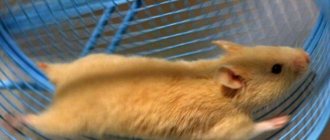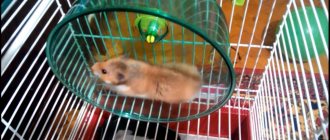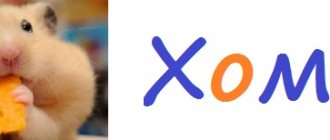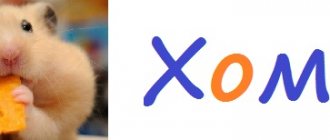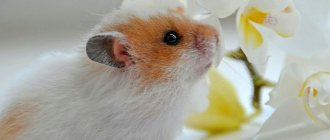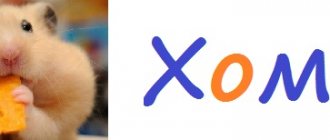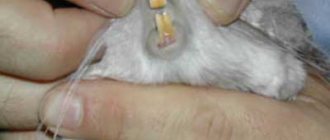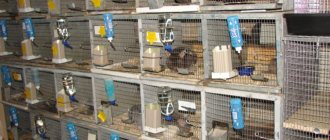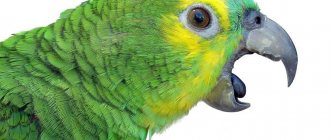Buying a squirrel
Buying a squirrel is quite difficult. This is a rare animal to keep at home, and it is strictly forbidden to take it home from the forest - it is a wild animal, it cannot be tamed, but it can easily be tortured to death. In this case, the squirrel may get sick.
The purchase can be made at a specialized nursery, if there is one nearby, you can try to place an order at a large pet store. At worst, you can try to go to the zoo, but you better not hope for that.
Little squirrels
Do not buy protein at the poultry market if your health is important to you.
The price of an animal varies from 5,000 rubles and above, which can also be considered an advantage of a pet.
Characteristics of a rodent
- Proportionally built body;
- Color – fiery brown, in winter – silver-fawn;
- There are long dark tassels on the ears;
- The tail is fluffy;
- Eyes – black;
- Body length - up to 31 cm. The tail is the same length;
- Weight – up to 1 kg;
- Life expectancy is up to 15 years at home. For comparison, in the wild they live 3-4 years.
The squirrel has a playful, inquisitive character and inexhaustible energy. She can spin the wheel for hours, jump off it at the same second, make a couple of dozen circles around the floors of the cage, and jump into the wheel again.
Cell research
The only thing is that at first they are cowardly, but this is just a precaution, then the squirrel will become gullible. But let us warn you - petting and cuddling her like a kitten is unlikely to work, they do not like physical affection, this is not a guinea pig
But there are also exceptions.
You also need to constantly communicate with them, because... Squirrels have a very short memory, they quickly run wild, and this is fraught with bites.
Diet
You need to feed the squirrel the same thing that it eats in nature:
- Berries;
- Fresh vegetables and fruits;
- Pine and spruce seeds;
- Mushrooms;
- Nuts (except almonds, which are poisonous to squirrels);
- Buds, shoots.
Contrary to the general belief that they are herbivores, squirrels eat insects, their larvae, frogs and shelled eggs. You can drink both water and milk. We fill the feeder 2 times a day - morning and evening, about 50 grams at a time. To prevent supplies from rotting, do not add too much food.
Squirrel eats
Never give a squirrel sweet, fried, salty, or any food from our table.
Beautiful fluffy animal
Of course, the squirrel is a very beautiful animal, but before buying, think again about whether you really need it, because there are more domestic rodents that bite and scratch less. And if you don’t change your mind, then be prepared to devote a little more time to communication than you expected, after all, the beauty, as in the photo above, is a wild animal.
And remember - we are responsible for those we have tamed!
How to choose a cage for degu (Chilean squirrel), care rules and diet.
DEGU
- a fast, sociable, cheerful, incredibly interesting animal, he always needs attention! It is recommended to have 2 or more animals in one cage. Degus are usually diurnal, with peak activity in the morning and early evening, but they also adapt well to their owners' home environment! Degu belongs to the category of heat-loving animals; this fact must be taken into account when choosing the location of the cage.
Whatever they are called: squirrel, bush rat, Chilean squirrel, Octodon degus, Octodon degus Molina. The animal's homeland is the foothills of the Andes of Peru and Chile. Locals call the degu a bush rat. In wildlife they feed on grasses, leaves of shrubs, tree bark, seeds, roots and fruits. They store food in burrows or bury it in the ground. In winter, they feed on dry leaves and hay.
APPEARANCE
options
: gray-brown, yellow-brown, sand, white, black, blue, lilac.
2. Body length from 9-23 cm, tail length 7-9 cm. Approximate weight 200-300 grams.
3. The fur is short, very soft. Petting such an animal is a pleasure! In the period from zero to two months (there are exceptions), baby hair changes to adult hair.
4. The muzzle is elongated, the eyes are slightly convex, dark brown or black, with vertical pupils, the ears are pointed and long. The nose is shorter than that of mice and has a more rounded shape.
5. Degus have fairly large oval-shaped ears. The hearing aid is very sensitive and allows them to hear sounds that are almost imperceptible to humans.
6. Degus have rather large eyes with a diameter of about 7-8 mm, almost round, with a color ranging from dark brown to black. Since the eyes are located almost opposite each other, the rodent's field of view is almost 360°, which allows it to observe what is happening around it, practically without moving its head. They see well up close, but not at distant objects. But in this case, the vibrissae, the organs of touch, come to the rescue. They are the ones who notify the rodent exactly where objects and prey are located.
7. Degus have 20 teeth. A pair of incisors on the upper jaw, a pair on the lower jaw. There are no fangs. Instead, there is a gap called a diastema. A certain arrangement of teeth allows rodents to gnaw through relatively hard materials and spit out particles of the latter through the diastema, without even taking them into the mouth.
8. The front legs of degus are short and have four toes and a vestigial thumb.
9. The tail is covered with short, coarse bristles. Toward the end of the tail, the hair becomes longer and forms a brush. When caught by the tail, they shed the skin, leaving it to the attacker, and run away. The exposed portion of the degu's tail is chewed off. Therefore, it is absolutely forbidden to grab and hold a degu by the tail.
GESTURES
AND BEHAVIOR
1. In silence, the ears press slightly towards the body; with a sharp sound, scream or rustle, they instantly open back up.
2. The fur stands on end – the pet is in a state of anxiety and feels threatened.
3. Increased activity in the form of running, jumping - this behavior indicates that the animal is in a joyful state, it is absolutely healthy and happy.
4. Squeaking - this is how degu proteins communicate with each other.
5. Wagging tail - excited state
NUTRITION
Degu is a herbivorous rodent. Every day, the degu's diet should include: a lot of high quality hay + leaves and grass as the main food. Hay is the basis of the diet of herbivores; it should always be in the cage. Hay contains a lot of carotene and fiber (which is necessary for animals), this is necessary for normal metabolism, growth, development, and it also contains all the necessary substances - digestible vegetable protein, vitamins, calcium, phosphorus, etc.
The diet should include: plantain, dandelion, clover, chamomile, mint and lemon balm, nettle, leaves and twigs: raspberries, apple trees, pears, black and red currants, blueberries, hazel, rose hips (flowers and leaves), lingonberries, etc., flowers of calendula (marigold), chicory, cornflower and other permitted herbs. In addition to basic nutrition, every day the degu should receive specialized food for degus (2-4 types for complete nutrition), healthy treats (flowers, berries, vegetables, etc.).
CARE
These rodents require constant care and proper maintenance. Pay special attention to studying the information about choosing and filling the cage, as well as its comfortable location for the animals.
1. A spacious cage is needed - for a couple of animals at least 80*50*80 cm, but the larger the better, because degus are territorial animals. Choose a cage with metal or wooden elements, since the plastic will be chewed very quickly, wood is necessary for sharpening teeth, and the wooden elements in the cages also need to be replaced after a while.
2. Be sure to put up a wooden house, which degus will chew over time. Choose wooden houses made of natural wood, without coating and without a smell that can repel animals. We recommend placing hanging hammocks, both open and closed, on the roof of the cage. The size must correspond to the size of the animal + 5 cm. Each degu has its own hammock.
3. There should be hay in the cage (specifically, in the hay box, it is not used as a filler). You can choose from two options: a ball haybox or an external metal haybox, from which the degus will draw the required amount of hay. In the summer you can give fresh grass, the condition is the cleanest place to collect the grass, or you can germinate the grass yourself (sold in our store, seeds with soil and instructions are included in the kit)
4. Filling in the cage: sawdust (bedding, do not pour granules under any circumstances - they cause painful calluses). Sawdust is soft, airy, pleasant for the paws. You can also use corn litter; it is hypoallergenic, soft on the paws and economical. Some squirrels may be allergic to pine needles; in this case, use corn filler or paper.
5. Glass or plastic drinking bowl. Water should always be fresh.
6. The feeder should be separate from the vegetable feeder and separate from the herbs. We recommend pouring complete feed into ceramic feeders with edges rounded inward, and herbs and fresh vegetables into hanging metal feeders.
7. A wheel (mesh or wooden from 28 cm), in which the animals run with pleasure.
8. Food should always be in the feeder; for degus you should purchase specialized food (in extreme cases, chinchilla food is suitable) - they consist of herbs, vegetables and grains and do not contain sugar. High-quality food should not contain fish, bone or other types of flour, salt, sugar, molasses or cane syrup, brewer's yeast (ideally), carob (carob), nuts, honey, or animal products. Degus are predisposed to diabetes, so they should not be given sweet or dried fruits. Degus' teeth are constantly growing, so the cage should have enough branches for gnawing on deciduous trees - linden, birch, apple trees. Degus are sociable, easily get used to being handled, recognize their owner by smell, keeping them at home and watching them is a great pleasure.
9. Degus are very clean, so they need regular bathing, as the health of the squirrel and the beauty of its fur will depend on this. Special sand (dust) for chinchillas is poured into the bath. Such a bath must be installed in the cage every day; in the evening it should be taken away, cleaned and the filler sifted. If this is not done, the animals will use it as a toilet.
10. Clean the cage every 7-10 days. General cleaning once every 1-1.5 months.
TRAINING
Degus are friendly animals, they make good contact with people and get accustomed to them quite quickly. It’s good to start dating at an early age; you need to pay attention to them every day. They have a good memory! The voice should be quiet and calm so as not to scare the animal. You can give food from your hands, just be sure to wash them before feeding. It is necessary to take not from above, since in nature the attack occurs from above, in this case the degu can be scratched or bitten. It’s good to let the animal run around indoors, or buy special metal fences in which they will spend some time under your supervision. But, if you still decide to let them walk around the room, the wires should not be accessible, there should be no gaps or inaccessible corners. Otherwise, the wires may be chewed, and they may hide in the cracks and not come out to you. Degus enjoy having their bellies rubbed. This way you can quickly make friends with your pet.
LIFESPAN
,
life expectancy at home is about 10 years. In the natural environment 5-8 years.
REPRODUCTION
Degus breed all year round (one or two litters per year). Females are able to become pregnant immediately after giving birth, so it is recommended to remove males immediately after the female is pregnant in order to avoid re-pregnancy and subsequent death of the female and offspring. Gestation lasts from 87 to 93 days, which is long on average for rodents, and litters typically contain one to six babies. The milk feeding period lasts from two to four weeks.
When observing animals in nature, it was noted that parents feed their cubs with young grass, which they bring into the hole.
Mating based on kinship is wrong. The female and male need to be introduced a few days in advance so that they get used to each other.
Average birth weight is 14 g.
DISEASES
AND TREATMENT
The first sign that something is wrong is lethargic behavior, the animal hides in the house and corner. Eyes must be clean, free of foreign stains. Look at your teeth; healthy ones are orange. If the color changes, change the diet. In addition, the animal is susceptible to colds, as it is exotic and loves a warm climate. Avoid drafts and sudden temperature changes.
The most
common diseases in DEGU PROTEIN :
1. Conjunctivitis. Expressed as purulent inflammation of the eyes. The disease can be cured using special drops that contain antibiotics.
2. Diabetes mellitus. The most common disease in squirrels. The animal becomes lethargic, gains weight and drinks a lot of fluid. It is impossible to cure the disease, so preventive measures should be taken: follow a diet, exclude sugar-containing foods from the diet.
3. Cataract. Most often, adult pets suffer from the disease. A characteristic white spot forms on the animal’s eye. You should contact your veterinarian for help.
4. Dental diseases, skin problems - baldness due to self-gnawing.
5. Other common disorders include: foodborne diarrhea, obesity, traumatic soft tissue injuries (bites, tail avulsions), and traumatic fractures. Reproductive system disorders are mainly associated with dystocia and pathological changes in the postpartum period.
6. High thermal conditions and direct sunlight lead to sunstroke and heatstroke
What types of homemade wheels are there?
It is a mistake to start building an attraction right away
First, you should understand the types of wheels and what criteria are important to choose a toy for an animal
First of all, we pay attention to the diameter of the simulator. It depends on the length of the pet itself
For the Syrian fluffy, the diameter of such equipment varies from 12 to 18 cm, and for the Dzhungarik - from 10 cm. If the animal is dwarf or is still in the process of growing, then a wheel with a smaller diameter is also suitable
When your pet grows up, it is important to replace the attraction with a suitable one.
The wheels also differ in the method of fastening. There are only 2 types:
- Those that are installed on a stand.
- Those that are attached to the bars of the cage.
The last option is considered to be the most safe and reliable. A wheel on a stand can cause harm to a fluffy cat if the necessary distance between the parts is neglected.
Materials and technical characteristics of running wheels
There are two types of running wheels for rodents:
- Cages attached to the grid.
- Pallet mounted.
Both types of fastening are convenient. The second is suitable for more spacious enclosures. Mandatory
– solid surface. That is, there should not be large gaps on the plane on which the animal runs. This is important, since the degu has a long tail, which, if caught in the gap between the steps of the spinning wheel, can break and fall off completely. This is the peculiarity of degus.
For Chilean squirrels it will be convenient to use a wheel with a diameter of 25-30 cm. The material can be any - metal, plastic, plexiglass. But a metal toy, of course, is more durable, although it costs more. The price of a running wheel can vary from 100 to 1000 rubles. It depends on the quality of the material, manufacturer and design of the device.
A degu wheel made of thin plastic can be dangerous for the animal. If a Chilean squirrel tries to chew on it, the low-quality material will easily succumb. And plastic fragments can injure your pet’s internal organs and also cause intoxication.
There is also the option to order a running wheel for degu made of wood. Such toys are reliable and safe. Craftsmen make such toys from hard wood. They are reliable and absolutely safe, even if your pet decides to try the wheel.
Step-by-step instructions on how to make a degu cage with your own hands
To imagine what the finished cage will look like, you can visit different pet stores and look at the products on offer. Also look at the work of other artists.
Preparatory stage
You need to start with a drawing. If you are an experienced craftsman and have a trained eye, then you can skip this step. But it’s better to make a drawing indicating all the dimensions and the amount of material needed. If you do not want to create a drawing yourself, use the proposed model.
After the drawing is transferred to paper, start preparing the necessary tools and materials.
You will need the following materials:
- nails;
- self-tapping screws or self-tapping screws;
- lining;
- wooden blocks;
- galvanized mesh;
- lock on the door.
Tools also needed:
- hammer;
- screwdriver or drill;
- hacksaw;
- metal scissors.
Make blanks based on existing drawings. Also indicate all dimensions and quantities in the drawing, and be guided by it when preparing for work. Once all the elements are ready, you can begin assembly.
Assembly
Assembly is carried out gradually, from bottom to top.
- First, assemble the bottom: make a base from wooden blocks and make a bottom from clapboard. Screw the bars with screws or self-tapping screws, so you can create a reliable base for the cage.
- Then make three walls. Screw the mesh to the base, and gradually make all three walls. For greater strength, you can make one wall from lining. Plexiglas is also a good option, in this case you will prevent the contents of the house from scattering outside.
- Separately, make another wall with a door. And leave it for now.
At this stage, it is worth taking a break and doing some internal arrangement.
If you do all the walls at once, it will be inconvenient to fill your home with various elements.
Filling
So that the animal can fully realize the need for activity, make a cage in several tiers, and place various objects inside. Among them the most suitable:
- shelves;
- thick branches;
- hammock;
- you can hang a rope along which your pet can climb to other floors;
- be sure to make a house;
- screw on the wheel (it’s easier to buy it ready-made).
Design the cage with love and care for your pet. Don’t be lazy once again to sand a sharp corner or prepare another shelf. But remember that you also cannot overdo it with filling - there should be a lot of free space in the home for comfortable movement.
Before purchasing a Chilean degu squirrel, it is important to prepare in detail everything necessary to ensure comfortable conditions for its life support. Despite its small size, the animal requires a large amount of free space.
Squirrels love to move a lot, play and be interested in the world around them.
The aviary industry puts on the market high-quality products at a high cost, which can be found in every store. You can save money and reproduce a degu cage with your own hands. The project does not require large investments.
The price of the issue is the minimum cost. If you wish, you can search the Internet for advertisements of those who want to give away the cage for free.
Squirrel training
Experts recommend trying to gain the squirrel’s trust from the earliest months and making attempts to train your pet. As soon as the pet becomes tame, he will be drawn to the person. Despite their tiny size, squirrels are capable of performing complex tricks.
They can not only jump high, but also dance
You can attract the degus's attention with a treat. The animal will definitely follow him
Thus, the rodent can learn to jump from knee to knee for a treat.
The “come to me” task is the most common for all types of animals. Training a degu to command “come to me” does not take much time. Especially if the animal knows in advance that it will receive a treat.
If there are several animals in the house, then you need to deal with them separately. Over time, they remember commands and easily demonstrate their skills to their owner.
In order for the result to be successful, the training process must be taken as responsibly as possible. Don't expect everything to work out right away.
Every team requires patience on the part of the owner. As soon as mutual understanding and trust are established between the owner and the pet, they will be able to perform even the most incredible tricks together.
General design requirements
The Chilean squirrel loves space, so its home should be spacious. Animals are very active, constantly on the move. Animals will not be able to show their activity within 4 walls, so they increase the area by adding shelves.
It is recommended to choose a multi-tiered cage with 2-4 shelves. To make cleaning easier, a tray is provided. What are the basic cage requirements for a degu squirrel:
optimal size for a pair of rodents: length 1.2 m, width 0.6 m, height 1 m. For a larger number of animals, a more spacious cage is needed; Plastic and wooden parts should be avoided. The material is easily susceptible to degu teeth. Plastic, fiberboard or MDF are harmful to the health of any animal; the cage should be made of metal mesh. The optimal distance between the rods is 1 cm. If the cage contains a female with puppies, then the distance is reduced to 0.5 cm; the rods must be strong. A degu squirrel can easily cope with a mesh made of thin twigs; Chilean squirrels live in burrows. They love to dig. This is inherent in them by nature. In order for them to successfully realize their instinct, it is necessary to choose a durable pallet. It is made of aluminum sheet and plexiglass. It is possible to adapt a plastic box, but all protruding parts must be covered with aluminum tape
The rodent will not be able to grasp a smooth surface; You also need to pay attention to the door lock. A degu will learn to open a simple latch
Animals are very smart and learn quickly. It is recommended to use a carabiner as a lock.
For degus, do not choose a cage for guinea pigs, for rabbits or for chinchillas. Animals are larger than squirrels: they have a larger spacing between bars. The structures are low. Squirrels will not be able to actively run in them. Bird cages are tall, but they won't work either.
They are not wide enough or deep enough. For degus, buy a special cage in the store, make it to order, or build a home for rodents yourself. If indoor space allows, it is better to purchase a display case for degu.
To choose the optimal cell size, adhere to the following indicators. They were compiled by zoologists. At the same time, all useful areas for degus were calculated: floor, shelves, house:
- in a structure with an area of 12,000 - 14,000 cm2, only 2 rodents can be located;
- a structure with an area of 15,000 - 18,000 cm2 is intended for 3 animals;
- 19,000 – 22,000 cm2 – 4 whites;
- 23,000 – 26,000 cm2 – 5 degus;
- 27,000 cm2 – 6 rodents.
The usable area is calculated as follows:
- if the floor length is 1 m, width is 0.5 m, then the area will be 5,000 cm2.
- the cage has a shelf 60 cm long. It is located on the side wall. Its area is 3,000 cm2;
- if the usable area is 8,000 cm2, then this is not enough even for one squirrel. Increase it by installing a new level or shelf;
- a level 1 m long and 50 cm wide gives an area of 5,000 cm2. A hole is made in this panel for the passage of animals, and it is equipped with a ladder;
- The useful area in a two-tier structure with 1 shelf will be 13,000 cm2. A pair of degus can live in such a dwelling.
These calculations must be taken into account when building cells with your own hands. Experts point out some more parameters that must be observed:
- the height of the cage should not exceed 1.2 m for 2 squirrels;
- the distance between tiers or shelves is maintained no more than 35 cm;
- for adults, the distance is increased to 50 cm.
The dimensions of structures for squirrels that are displayed in stores do not always correspond to the standards, so degus breeders often assemble corners for their pets themselves.
Main equipment
The Chilean squirrel is a herbivorous rodent. They eat hay, fresh grass, and vegetables. They can eat sour fruits and berries as a treat. Rodents receive nuts in small quantities: walnuts, hazelnuts, peanuts, almonds.
For rodents, you also need to prepare hemp, branches, and bark. They must constantly chew them and sharpen their teeth. To fully maintain rodents, you need to purchase the following equipment:
- sennitsa It can be in the form of a ball made of wire, or in the form of a sleigh that is fixed to the wall of the cage;
- tank for dry or wet food: green grass, vegetables, fruits;
- drinking bowl for degu. This is a bowl or nipple device. For degus, it is better to choose vacuum drinkers, but the plastic container should be placed behind the cage or protected with a net;
- bathhouse. This is a tank or house with filler. Degus need to be bathed and washed using sand baths, which wash the fur of grease and dirt;
- a house or other structure for degus. In the wild, rodents live in burrows, so they require a closed distance from the house so that they do not wet the filler in the house;
- toilet. Use a steel or wooden bath with filler. Cat litter is suitable for rodents. They themselves find in which corner they will have a toilet. The place can be changed according to the litter. It is better to place a reservoir with filler in this corner;
- litter Corn husks and wood shavings are used. Sawdust is not suitable, especially for a terrarium, as it provokes allergies in animals. Peat is also not used, it creates a lot of dirt, but this filler allows keeping squirrels at home closer to wild conditions;
- Zeolite or palygorskite is used as a bath filler. Plain river or quartz sand is not suitable. It does not absorb moisture and cannot remove grease from animal hair. Bath filler can be purchased at a pet store. Products for chinchillas are sometimes used because they resemble degus.
What part of a watermelon can you give to a squirrel?
The squirrel should be given a small piece of red pulp only as a sweet treat. Before doing this, you need to cut off the crust. There is no need to feed the degu a lot of it often, because its body is adapted to grain food.
It is better not to pamper your rodent with this delicacy more than twice a week. Moreover, watermelon is a diuretic product, so you will often have to change the squirrel’s bedding.
Watermelon rinds and seeds on the degu menu
Many owners of decorative squirrels believe that their pet can only be limited to eating the rind of a watermelon. But this is not true, because it often collects toxic substances that can harm the pet’s health.
Moreover, there is nothing healthy in the peels, so you should not give them to the squirrel. Watermelon seeds can be given to degus little by little.
It is important to observe moderation in everything
It is forbidden to give the seeds raw; frying them is prohibited. The seeds can be stored for the winter. To do this, they are dried and systematically added to the degu's main diet.
How to choose the right watermelon?
The product you plan to treat the squirrel with must be fresh and juicy.
You should not give degus:
- unripe and rotten watermelon;
- the aroma of the berry pulp should be fresh and pleasant, without foreign odors;
- a good watermelon has a uniform flesh color;
- You cannot feed it to an animal if the flesh inside is glossy in color with yellow-white veins. This indicates the presence of nitrates.
Composition of the product
Watermelon seeds accumulate many nutritional components that are necessary for the development of the embryo and sprout. The core contains fats, proteins, carbohydrates, vitamins and mineral salts. Experts identify the following composition of watermelon seeds:
- more than 50 g of fat per 100 g of product;
- 32 g protein;
- 12% carbohydrates, which means 15 g;
- high energy value 557 kcal;
- among the vitamins there are folates; there are more than 54 mg of them in the seeds. They take part in the metabolic process, in the work of the heart and blood vessels;
- 3.6 mg of nicotinic acid - improves the condition of blood vessels, thins the blood, normalizes heart function, acid eliminates the risk of stroke.
Despite the rich chemical composition of the seeds, the squirrel needs to be fed them in limited quantities. The permitted limit is 5 pieces per week. You can't give it every day. Treats are always given after the main food has been taken.
The benefits and harms of watermelon seeds
As a tasty treat, zookeepers give squirrels sunflower, zucchini and pumpkin seeds. On the Internet and on forums you can find discussions among rodent owners: can degus be given watermelon? Experts say that you can’t feed watermelon, but you can feed it seeds.
They are considered healthy treats. When taking the seeds, stress in rodents is reduced, immunity is increased, blood circulation and microcirculation are stabilized. This is an excellent prevention against thrombosis.
If you give the seeds every day, they can cause obesity and protein intoxication in the squirrel. Foods should be given in moderation. Can you use watermelon instead of degu seeds? Veterinarians answer negatively.
The juicy pulp contains a lot of sugar, which can cause hyperglycemia and sharply increase blood sugar. It is useful to give treats to the Chilean squirrel in limited quantities. Otherwise, you will harm your pet's health, cause obesity, intoxication and diabetes.
Housing for Degus
Of course, if you are planning to get a Degu squirrel, then you should worry about the animal’s place of residence. Iron cages with fine bars or a terrarium covered with a mesh lid on top are suitable housing for this rodent. According to reviews about Degu, it is more convenient to keep the animal in a terrarium. So, the squirrel does not have the desire to chew through the bars. In addition, debris does not spill out of the closed structure, which makes caring for the Degu much easier. However, the terrarium also has disadvantages. For example, in such a design it is more difficult to build floors for additional pallets and the “running around” of a pet. Therefore, the required area has to be increased in length or width. You need to increase the space at the rate of 95*65*45 cm for one rodent.
Also, some breeders keep Degus in aquariums covered with a net. This option is highly not recommended, since there is poor air exchange in such a container. In addition, the aquarium is not suitable for attaching a drinking bowl, a house and “toys”.
As practice shows, the opinions of owners on the issue of a place to keep an animal are divided: some choose a terrarium for reasons of cleanliness, others prefer to watch the Degu in a cage - this gives more opportunities for the rodent’s pranks and saves space.
If you have chosen a cage, you should not choose one with a plastic bottom - the rodent will simply gnaw a hole in it and run away to travel. The ideal option is a metal cage with a lattice bottom under which there is a plastic trash tray. Cleaning such a kennel is much more convenient; just remove the tray, wash it and put it back in place. The minimum cage size for degu is 80*50*40 per rodent.
The Degu cage or terrarium should be placed in a quiet, warm place without drafts or sunlight. Degus are very sensitive to changes in temperature, increased or decreased humidity, drafts and noise. Constant hypothermia (temperature below +18) is especially destructive for the animal. The ideal temperature for normal life of squirrels is +25-+26 degrees. Do not place Degus:
- near a place where there are strong odors;
- near the TV;
- in a noisy place;
- near the battery;
- near a pond or aquarium;
- under direct sunlight.
It is also worth noting that in nature Degus are mainly hunted by birds, so the animal will not feel comfortable if it is very low. If the Degu cage is on the floor, a person passing nearby will instinctively be perceived as a danger. To protect the animal from stress, it is optimal to place the pet’s cage at least 1.4 meters from the floor.
Running wheel designs
Manufacturers offer many types of running wheels, differing in design, mounting method, and material. Let's talk about the main varieties.
Stairs
Their running surface consists of crossbars. It is convenient for the rodent to push off, grabbing the crossbar not only with its claws, but also with its fingers. Disadvantage: the foot may fall into the gap, which can lead to injury. Careful selection of wheel size allows you to avoid injury.
For babies and dwarf breeds of hamsters, a diameter of 9-16 cm is recommended - models Darell, Inter Zoo, Triol, IPTS. The distance between the crossbars is carefully calculated - the likelihood of injury is minimized.
The Green Farm model hamster wheel on a stand is made of wood - a safer option and an excellent design solution. Suitable for adult dzhungarik, white mice, cubs of dwarf breeds - diameter 16 cm.
Solid plastic
Solid surface with relief for ease of repulsion. Models Triol WL05 and silent hamster wheel IPTS are equipped with sides that prevent the pet from falling out when running. The Triol Sputnik wheel has a parabolic shape - it is safe and designed for the smallest animals.
When choosing a model, pay attention to the installation method:
- Stand – installed on the floor, suitable for spacious cages.
- Wall mount – fixed on the cage lattice, allowing you to maintain space for the animal to move. If the kit does not include a fastening device, you can use improvised means - strong wire, cord.
https://www.youtube.com/watch?v=ytpolicyandsafetyru
For owners who have not decided on the choice of installation method, we recommend a universal model - Inter Zoo metal hamster stair wheels, the stand of which is equipped with hooks for hanging. The hamster wheel on the stand must be stable - we recommend additionally securing the device to the wall with a rope.
Making a display cage
An original option could be a cage in the form of a display case. The process of creating such a structure is exactly the same as designing a wire degu cage. The degu display case differs in the constituent materials from which it is planned to create the enclosure.
The front and side walls are made of glass. The frame itself, together with the rear part, is created according to the standard scheme.
The sides are covered with galvanized mesh. The remaining parts are covered with glass. The front part of the enclosure is similar to a sideboard - two glass doors and a lock. One of the main advantages of such a display case is that leftover food, crumbs or sawdust do not fly outside the degu cage.
Through glass it is much more convenient to follow your pet - he is always in sight. Homemade cages in any form, if a person has a gift for designing and creating strong crafts, then the result is an excellent, strong structure.
Making shelves
Shelves are one of the main components of the enclosure. They are made from safe materials, most often wooden. To prevent wood from absorbing an unpleasant odor during long-term use when exposed to moisture, the surface must be disinfected and replaced regularly.
Metal shelves are strictly prohibited, as animals may develop corns. Degus love houses with several floors (levels). The shelves create just the right structure
It is important to secure them well and position them so that the possibility of a degu falling from a height is excluded.
Proper equipment will play a significant role in complementing a spacious, comfortable home. The animal will feel as comfortable as possible, ensuring a happy longevity. The most important elements for arranging degu cages are listed.
House or shelter
Despite the sociability of the pet, he needs a strong house in which he will hide and relax. The standard shelter size is 12x20x15cm. Most often, the house is created from coniferous wood.
The animal will not be able to chew through the house, since the bitter taste of the material will only repel it. Clay pots, vases or ceramics can also make good hiding places.
Sand for bathing
In order to cleanse its fur of sebum and excess moisture, degus need to constantly take a sand bath. The bathing suit should always be in the house and updated every day.
If desired, you can reduce bathing to 3 times a week. After taking the procedures, the bath needs to be taken out, since the degu can use it as a toilet.
Plain bath sand will not work. The skin is too delicate and can be injured. It is recommended to buy a specialized mixture for bathing chinchillas in a store or order online.
Wheel
The obligatory element that degus love most is the wheel. The animals constantly spin it like a spinning top. Squirrels often spin the wheel. The structure is made of organic or metal. Otherwise, it can be covered with a cloth.
This will make it easier and smoother for the degu to move around, avoiding corns.
It is important to ensure that there are no gaps in the structure. The tail can get caught in there and break easily.
The standard wheel size for squirrels is 20 cm in diameter.
Degu wheel
Hammock
The main activity of degus occurs during the daytime. They prefer to relax after games in an open area, for example, on a hammock. To create a hammock, dense natural fabric is used, without synthetics.
The hammock is hung from one of the upper corners of the enclosure. The degu climbs up the pipe to the hammock and securely settles down to rest. The bed is firmly fixed, as squirrels like to rest together.
Rules for using a degu wheel
- The running wheel should not be installed too high in the cage. Since jumping off it, the animal can be injured.
- Make sure that there are no sharp nicks or parts on the surface of the degu wheel. If there are all of them, smooth them out with a file or sandpaper.
- A couple of times a month, lubricate the wheel mechanism with vegetable or machine oil, then its movement will be smoother and more silent.
- If a new addition is expected to the degu family, it is better to remove the wheel from the cage. Firstly, excessive physical activity is contraindicated for a pregnant female. Secondly, newborn degus can be injured by a toy.
We invite you to familiarize yourself with: Toys for puppies, useful accessories for education and development
Distinctive features of degus
The Chilean squirrel is small in size, but has a long tail. The body is covered with thick fur of brown color with a yellowish tint. There are lighter colored animals. Their fur is greyish and silvery. The natural color is called agouti: the hair near the body is light, it darkens towards the tip. Home breeders have bred colored degus of various colors: cognac, blue, spotted, gray. Some have a color similar to a Siamese cat. Agouti-colored individuals are found in the wild. Rodents are small, but larger than mice and dormouse. To choose the right cage for degu squirrels, you need to know how many centimeters the length of its body is:
- in an adult common degu, the body length can reach 22 cm. Larger Chilean squirrels have been found in nature. Their body length was 40 cm, but this is considered rare. The animal is active during the day. At night, rodents climb into holes. Squirrels live in families. It includes 1-2 males, 3-4 females and offspring. The leader is the largest degu;
- Bridges' degus are not as large as individuals of the common species. Their body length is 9 cm. Animals prefer rocky terrain and beech forests. They don't build burrows. In times of danger, they hide under stones and tree roots. Squirrels climb trees well and move quickly along steep cliffs. Bridges' degus are nocturnal;
- Moon-toothed degus are small rodents. Its body length is 12 cm. The animal prefers mountains. Animals can be found at an altitude of 5 thousand m above sea level. They tolerate large temperature changes well. During the day, animals are inactive. These are nocturnal squirrels. They have well-developed night vision;
- The body length of the dormouse degu is up to 18 cm. The animals are nocturnal. They spend the day in burrows, but the tunnels are not as complex as those of the common species. Rodents live under cacti and under the roots of acacias. Some animal species are common in mountain ranges. Here they do not dig underground shelters for themselves. They nest in rock crevices;
- The Pacific degu prefers a humid climate. He lives on the ocean coast. Its limbs are adapted for digging holes and climbing trees. The animal grows up to 20 cm.
All Chilean squirrels have the same tail length, 10-12 cm. It is evenly covered with bristles. Towards the end the hairs become longer. They form a fluffy brush. Its length is about 6 cm. The animal raises its tail: it is slightly rounded towards the back. You always want to touch the tassel on the tail, but you shouldn’t do this. The squirrel sheds the skin on its tail and runs away. In this way she escapes from danger. The animal gnaws off the exposed part of the tail. The wound heals quickly and the tail no longer grows back.
The body weight of the Chilean squirrel is from 130 to 300 g. The weight of newborn puppies is no more than 14 g, but they grow quickly. In the first 2 weeks, they add up to 3 g. Subsequently, up to week 6, their weight increases by 15 g per day. Puppies show their greatest growth at the age of 4-8 weeks. Weight gain per day can reach 24 g. At 8 months, the weight of the female reaches 220 g, the male 300 g. Individuals enter the puberty phase. Crossbreeding can be done at 12 months.
All degus have a very well developed sense of smell. They remember smells and hold them in their heads for a long time. Their acute sense of smell helps them hide from danger. If a domestic rodent is offended by one of the family members, a cat or a dog, then it will remember the smell of its offender and will always show aggression towards him.
Distinctive features
One of the features of degus is their constantly growing powerful teeth. In order to maintain their integrity and beauty, squirrels need to eat tree branches in order to regularly grind down their teeth
As a rule, rodents try to chew anything that attracts their attention.
The owner needs to keep all the furniture in the house safe in advance while the animal is walking around the rooms. Like all living creatures, degus marks its territory. A person does not detect unpleasant odors emanating from degus, because there are none.
In a family with a small child, it is not advisable to talk about buying a degus. Children reach out to small fluffy animals to pet them, pick them up and cuddle them, which squirrels absolutely cannot stand. A pet can bite hard or injure a child’s delicate skin with sharp claws.
Bite wounds do not go away for a very long time. If a degu is in a rage, it can bite through a bone. The animal should not be picked up by the back, pulled or touched by the tail. The pet will mistake this action for attempts to attack.
